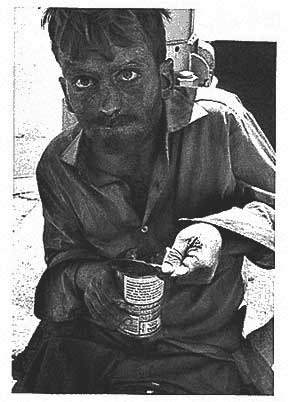 |
|
Pat
Love is walking from Ottawa to Peterborough to mobilize public
support for a solution to Ontario’s social housing crisis.
Homelessness is the starkest sign of the crisis. It’s
growing in many parts of the province, including Ottawa, Peterborough,
Toronto, Kitchener, Hamilton and even in some remote and rural
areas.
In Ottawa, on any given night, 850 men, women and children
are sheltered in the city’s emergency hostels. Between
January 1997 and December 2000, there was a 24 per cent increase
in the number of bed nights for all individuals in emergency
shelters. A City of Ottawa report says the worsening situation
is fed by poverty and a severe shortage of affordable housing.
In Toronto, about 4,900 individuals are sheltered nightly,
and the number is steadily rising. A Canadian Press survey
found that "once population differences are taken into
account, the percentage of people in Toronto using shelters
is actually 15.8 per cent higher than in New York."
The crisis extends well into the field of publicly assisted
social housing for low income earners. Where’s Home,
a survey of 21 communities by the Co-operative Housing Federation
of Canada found that:
• one in four tenant households – hundreds of thousands
of renters – all over Ontario is at risk of homelessness;
• in most parts of Ontario, tenant incomes are falling
even as rents rise faster than inflation;
• about 16,000 new rental units are needed annually according
to Canada Mortgage and Housing Corporation, but almost no
new affordable rental housing is being built.
Peterborough has the distinction of having the highest percentage
of tenant households on the brink of homelessness in Ontario.
A Social Planning Council survey covering 502 family members
classified as homeless or near homeless found as many staying
with friends or on the streets as there were in shelters.
The survey found 70 per cent can’t afford basic necessities
such as food, clothing, personal hygiene products, telephone,
or transportation.
In Ottawa, the number of social housing units has remained
static at about 23,400 units since 1997. Applications for
social housing units jumped from 2,900 in 1997 to 6,500 in
2000. Only 1,857 applicants were accommodated last year. Despite
the city’s booming economy, many people live in poverty.
In recent years 24,000 renter households have paid more than
half of their income for rent.
Several housing interest groups have documented the problem.
Increasingly, they are being joined by private sector calls
for action. The Toronto Board of Trade says: "All levels
of government must work together to improve support services
and access to affordable housing for those who are homeless
or at risk of becoming so." Mitchell Cohen, President
of one of Ontario’s largest builders, wrote recently
in The Globe and Mail: "We all have to recognize shelter
as a fundamental human need and to commit the resources to
ensure that each of us has a safe, secure and affordable place
to call home."
You can find more information of social housing by going to:
www.housingagain.web.net
...back
|

